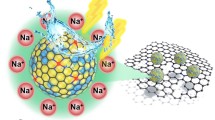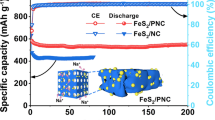Abstract
Abundant FeS2 with high theoretical capacity is one of the promising anode candidates in sodium-ion batteries (SIBs), however, the uneven sodium deposition due to the poor interface compatibility and sluggish reaction kinetics because of the high activation barrier still plague its practical application. Herein, we synthesized the ordered porous carbon matrix wrapped FeS2 nanoparticles (FeS2@OCN) with high sodium wettability and low pore tortuosity to economically enhance the interface compatibility as well as to lower the energy barrier in SIBs. The synergistic effects of low tortuosity pores and strong sodium wettability homogenize the Na+ flux distribution, bring the electron dislocation via the enrichment of edge-nitrogen (Pyridinic N and Pyrrolic N), thus achieving the dendrite-free sodium deposition and dramatically enhanced reaction kinetics. Benefiting from exceptional structural/compositional/electronic merits, the resultant anode is endowed with exceptional structure stability, achieving long-term cycling stability of 451.9 mAh·g−1 after 1000 cycles at 1 A·g−1 with specific capacity retention of 92.9%. Attenuated electrode tortuosity and high sodium wettability can corporately improve the interface compatibility and attenuate the activation barrier of the FeS2 host and beyond.
摘要
肖瑶瑶, 刘义慧, 刘兵兵, 齐振国, 张柚滨, 刘福胜, 秦国辉1.青岛科技大学化工学院生态化工国家重点实验室培育基地 2.山东省生态化工协同创新中心. 摘要 (Chinese Abstract): 储量丰富的FeS2具有较高的理论容量, 并被认为是很有前途的钠离子电池 (SIB) 负极材料候选者之一。然而, 较差的界面兼容性引起的钠离子不均匀沉积和较高的活化能垒导致的反应动力学缓慢仍然限制了它的实际应用。因此, 我们合成了具有高钠润湿性和低孔弯曲度的多孔碳包裹着的FeS2纳米颗粒 (FeS2@OCN), 最终提高了界面兼容性并降低了活化能垒。在低孔弯曲度和高钠润湿性的协同作用下实现了钠离子通量的均匀分布, 边缘氮 (吡啶氮和吡咯氮) 的掺杂可以促进电子的聚集, 从而抑制了枝晶钠的生长并提高了反应动力学。得益于独特的结构/组成/电子优势, 制备的FeS2@OCN具有优异的结构稳定性, 在1 A g−1下循环1000次后放电容量保持在451.9 mAh g−1, 容量保持率为92.9%。着眼于钠润湿性和孔弯曲度可以改善界面兼容性并降低FeS2基材料的活化能垒。
Graphical Abstract







Similar content being viewed by others
References
Pu X, Wang H, Zhao D, Yang H, Ai X, Cao S, Chen Z, Cao Y. Recent progress in rechargeable sodium-ion batteries: toward high-power applications. Small. 2019;15(32):1805427. https://doi.org/10.1002/smll.201805427.
Zhou X, Yu Z, Yao Y, Jiang Y, Rui X, Liu J, Yu Y. A high-efficiency Mo2C electrocatalyst promoting the polysulfide redox kinetics for Na–S batteries. Adv Mater. 2022;34(14):2200479. https://doi.org/10.1002/adma.202200479.
Liu Y, Li W, Xia Y. Recent progress in polyanionic anode materials for Li (Na)-ion batteries. Electrochem Energy Rev. 2021;4(3):447. https://doi.org/10.1007/s41918-021-00095-6.
Tsao Y, Gong H, Chen S, Chen G, Liu Y, Gao TZ, Cui Y, Bao Z. A nickel-decorated carbon flower/sulfur cathode for lean-electrolyte lithium-sulfur batteries. Adv Energy Mater. 2021;11(36):2101449. https://doi.org/10.1002/aenm.202101449.
Jin T, Li H, Zhu K, Wang PF, Liu P, Jiao L. Polyanion-type cathode materials for sodium-ion batteries. Chem Soc Rev. 2020;49(8):2342. https://doi.org/10.1039/C9CS00846B.
Ye Z, Jiang Y, Li L, Wu F, Chen R. A high-efficiency cose electrocatalyst with hierarchical porous polyhedron nanoarchitecture for accelerating polysulfides conversion in Li–S batteries. Adv Mater. 2020;32(32):2002168. https://doi.org/10.1002/adma.202002168.
Liu DQ, Ma JQ, Gao LF, Cai J, Yu C, Xie J. High-performance Si/C anode material constructed with 2D chitin nanosheets. Chin J Rare Metals. 2022;46(9):1125. https://doi.org/10.13373/j.cnki.cjrm.XY21030001
Fan L, Lu B. Reactive oxygen-doped 3D interdigital carbonaceous materials for Li and Na ion batteries. Small. 2016;12(20):2783. https://doi.org/10.1002/smll.201600565.
Wang J, Wang Z, Ni J, Li L. Electrospun materials for batteries moving beyond lithium-ion technologies. Electrochem Energy Rev. 2022;5(2):211. https://doi.org/10.1007/s41918-021-00103-9.
Huang X, Li R, Sun C, Zhang H, Zhang S, Lv L, Huang Y, Fan L, Chen L, Noked M, Fan X. Solvent-assisted hopping mechanism enables ultrafast charging of lithium-ion batteries. ACS Energy Lett. 2022;7(11):3947. https://doi.org/10.1021/acsenergylett.2c02240.
Sun YY, Li SQ, Wang CR, Qian YX, Zheng SY, Yuan T. Research Progress of Layered Transition Metal Oxide Cathode Materials for Sodium Ion Batteries. Chin J of Rare Met. 2022,46(6):776.https://doi.org/10.13373/j.cnki.cjrm.XY22020014.
Fang SJ, Du P, Zhang JF, Wang CH, Xiao ZM, Zhang B, Cao L, Fan XM, Ou X. Quasi-two-dimensional bismuth oxychalcogenide nanoflakes as novel anode for potassium-ion batteries. Rare Metals. 2022;41(8):2567. https://doi.org/10.1007/s12598-022-01970-x
Guo YM, Zhang LJ. Research Progress in Synthesis and Electrochemical Performance of Cobalt Sulfide as Anode Material for Secondary Batteries. Chin J of Rare Met. 2022,46(2):227. https://doi.org/10.13373/j.cnki.cjrm.XY20050006
Yang Y, Xu L, Yang SJ, Yan C, Huang JQ. Electrolyte inhomogeneity induced lithium plating in fast charging lithium-ion batteries. J Energy Chem. 2022;73:394. https://doi.org/10.1016/j.jechem.2022.06.001.
Cuo XB, Wang JC, Li GJ, Gao B, Bie CY, Zhang YP. Preparation and lithium-ion storage properties of vanadium nitride/nano silicon/carbon composite microspheres. Chin J Rare Met. 2022;46(6):829. https://doi.org/10.13373/j.cnki.cjrm.XY21090023
Zhang H, Yang Y, Ren D, Wang L, He X. Graphite as anode materials: fundamental mechanism, recent progress and advances. Energy Storage Mater. 2021;36:147. https://doi.org/10.1016/j.ensm.2020.12.027.
Xu J, Shen L, Shi K, Cao T, Lv W, He YB. A robust integrated SnOx/carbon composite anode for sodium-ion batteries. ChemistrySelect. 2018;3(39):10869. https://doi.org/10.1002/slct.201802425.
Liu Y, Sun Z, Sun X, Lin Y, Tan K, Sun J, Liang L, Hou L, Yuan C. Construction of hierarchical nanotubes assembled from ultrathin V3S4@C nanosheets towards alkali-ion batteries with ion-dependent electrochemical mechanisms. Angew Chem Int Ed. 2020;59(6):2473. https://doi.org/10.1002/anie.201913343.
Liu S, Feng J, Bian X, Liu J, Xu H, An Y. A controlled red phosphorus@Ni-P core@shell nanostructure as an ultralong cycle-life and superior high-rate anode for sodium-ion batteries. Energy Environ Sci. 2017;10(5):1222. https://doi.org/10.1039/C7EE00102A.
Zhu L, Yang XX, Xiang YH, Kong P, Wu XW. Neurons-system-like structured SnS2/CNTs composite for high-performance sodium-ion battery anode. Rare Met. 2021;40(6):1383. https://doi.org/10.1007/s12598-020-01555-6.
Sun Z, Zhu K, Liu P, Chen X, Li H, Jiao L. Fluorination treatment of conjugated protonated polyanilines for high-performance sodium dual-ion batteries. Angew Chem Int Ed. 2022;61(42):e202211866. https://doi.org/10.1002/anie.202211866.
Wang GY, Wang XH, Sun JF, Zhang YM, Hou LR, Yuan CZ. Porous carbon nanofibers derived from low-softening-point coal pitch towards all-carbon potassium ion hybrid capacitors. Rare Metals. 2022;41(11):3706. https://doi.org/10.1007/s12598-022-02067-1
Li X, Qi SH, Zhang WC, Feng YZ, Ma JM. Recent progress on FeS2 as anodes for metal-ion batteries. Rare Met. 2020;39(11):1239. https://doi.org/10.1007/s12598-020-01492-4.
Ye S, Wang L, Liu F, Shi P, Yu Y. Integration of homogeneous and heterogeneous nucleation growth via 3D alloy framework for stable Na/K metal anode. eScience. 2021;1(1):75. https://doi.org/10.1016/j.esci.2021.09.003.
Xiao B, Zhang H, Sun Z, Li M, Fan Y, Lin H, Liu H, Jiang B, Shen Y, Wang MS, Li M, Zhang Q. Achieving high-capacity and long-life K+ storage enabled by constructing yolk-shell Sb2S3@N, S-doped carbon nanorod anodes. J Energy Chem. 2023;76:547. https://doi.org/10.1016/j.jechem.2022.09.050.
Liu L, Xie ZH, Deng QF, Hou XX, Yuan ZY. One-pot carbonization enrichment of nitrogen in microporous carbon spheres for efficient CO2 capture. J Mater Chem A. 2017;5(1):418. https://doi.org/10.1039/C6TA09782K.
Segall MD, Philip JDL, Probert MJ, Pickard CJ, Hasnip PJ, Clark SJ, Payne MC. First-principles simulation: ideas, illustrations and the CASTEP code. J Phys: Condens Matter. 2002;14(11):2717. https://doi.org/10.1088/0953-8984/14/11/301.
Perdew JP, Burke K, Ernzerhof M. Generalized gradient approximation made simple. Phys Rev Lett. 1996;77(18):3865. https://doi.org/10.1103/PhysRevLett.77.3865.
Cheng G, Zhang W, Wang W, Wang H, Wang Y, Shi J, Chen J, Liu S, Huang M, Mitlin D. Sulfur and nitrogen codoped cyanoethyl cellulose-derived carbon with superior gravimetric and volumetric capacity for potassium ion storage. Carbon Energy. 2022;4(5):986. https://doi.org/10.1002/cey2.233.
Hao R, Ren JT, Lv XW, Li W, Liu YP, Yuan ZY. N-doped porous carbon hollow microspheres encapsulated with iron-based nanocomposites as advanced bifunctional catalysts for rechargeable Zn-air battery. J Energy Chem. 2020;49:14. https://doi.org/10.1016/j.jechem.2020.01.007.
Liu Y, Ai K, Lu L. Polydopamine and its derivative materials: synthesis and promising applications in energy, environmental, and biomedical fields. Chem Rev. 2014;114(9):5057. https://doi.org/10.1021/cr400407a.
Wang L, Guan H, Huang Q, Hu J, Dong C, Wang Y. Fe3O4/Fe/C composites prepared by a facile thermal decomposition method and their application as microwave absorbers. J Alloys Compd. 2019;784:1123. https://doi.org/10.1016/j.jallcom.2019.01.113.
Wang HB, Wang JQ, Zhang R, Cheng CQ, Qiu KW, Yj Y, Mao J, Liu H, Du M, Dong CK, Du XW. Bionic design of a Mo(IV)-doped FeS2 catalyst for electroreduction of dinitrogen to ammonia. ACS Catal. 2020;10(9):4914. https://doi.org/10.1021/acscatal.0c00271.
Sun Z, Yang X, Lin H, Zhang F, Wang Q, Qu F. Bifunctional iron disulfide nanoellipsoids for high energy density supercapacitor and electrocatalytic oxygen evolution applications. Inorg Chem Front. 2019;6(3):659. https://doi.org/10.1039/C8QI01230J.
Zhang J, Li W, Wang J, Pu X, Zhang G, Wang S, Wang N, Li X. Engineering p-Band center of oxygen boosting H+ intercalation in δ-MnO2 for aqueous zinc ion batteries. Angew Chem Int Ed. 2022. https://doi.org/10.1002/anie.202215654.
Li Z, Zhang F, Cao T, Tang L, Xu Q, Liu H, Wang Y. Highly stable lithium–sulfur batteries achieved by a SnS/porous carbon nanosheet architecture modified celgard separator. Adv Funct Mater. 2020;30(48):2006297. https://doi.org/10.1002/adfm.202006297.
Zhu LM, Ding GC, Han Q, Miao YX, Li X, Yang XL, Chen L, Wang GK, Xie LL, Cao XY. Enhancing electrochemical performances of small quinone toward lithium and sodium energy storage. Rare Met. 2022;41(2):425. https://doi.org/10.1007/s12598-021-01813-1.
Zong L, Chen X, Dou S, Fan K, Wang Z, Zhang W, Du Y, Xu J, Jia X, Zhang Q, Li X, Deng Y, Chen Y, Wang L. Stable confinement of Fe/Fe3C in Fe, N-codoped carbon nanotube towards robust zinc-air batteries. Chin Chem Lett. 2021;32(3):1121. https://doi.org/10.1016/j.cclet.2020.08.029.
Yang J, Tan R, Li D, Ma J, Duan X. Ionic liquid assisted electrospinning of porous LiFe0.4Mn0.6PO4/CNFs as free-standing cathodes with a pseudocapacitive contribution for high-performance lithium-ion batteries. Chem-Eur J. 2020;26(24):5341. https://doi.org/10.1002/chem.201905140.
Zhai P, Zhang Y, Wu Y, Gao J, Zhang B, Cao S, Zhang Y, Li Z, Sun L, Hou J. Engineering active sites on hierarchical transition bimetal oxides/sulfides heterostructure array enabling robust overall water splitting. Nat Commun. 2020;11(1):5462. https://doi.org/10.1038/s41467-020-19214-w.
Liu Y, Li M, Zheng Y, Lin H, Wang Z, Xin W, Wang C, Du F. Boosting potassium-storage performance via the functional design of a heterostructured Bi2S3@RGO composite. Nanoscale. 2020;12(48):24394. https://doi.org/10.1039/D0NR06457B.
Li P, Qi X, Zhao L, Wang J, Wang M, Shao M, Chen JS, Wu R, Wei Z. Hierarchical 3D porous carbon with facilely accessible Fe–N4 single-atom sites for Zn-air batteries. J Mater Chem A. 2022;10(11):5925. https://doi.org/10.1039/D1TA08050D.
Wang P, Qi X, Zhao W, Qian M, Bi H, Huang F. Nitrogen-doped hierarchical few-layered porous carbon for efficient electrochemical energy storage. Carbon Energy. 2021;3(2):349. https://doi.org/10.1002/cey2.78.
Li H, Chen Y, Jin Q, Xiang W, Zhong B, Guo X, Wang B. Fe-Nx sites enriched microporous carbon nanoflower planted with tangled bamboo-like carbon nanotube as a strong polysulfides anchor for lithium-sulfur batteries. Green Energy Environ. 2021;6(4):506. https://doi.org/10.1016/j.gee.2020.06.004.
Deng S, Tie Z, Yue F, Cao H, Yao M, Niu Z. Rational design of ZnMn2O4 quantum dots in a carbon framework for durable aqueous zinc-ion batteries. Angew Chem Int Ed. 2022;61(12):e202115877. https://doi.org/10.1002/anie.202115877.
Wang A, Hong W, Li L, Guo R, Xiang Y, Ye Y, Deng W, Zou G, Hou H, Ji X. Bi3Se4 nanodots in porous carbon: a new anode candidate for fast lithium/sodium storage. Energy Storage Mater. 2022;53:1. https://doi.org/10.1016/j.ensm.2022.08.042.
Cheng Z, Fan XY, Yu L, Hua W, Guo YJ, Feng YH, Ji FD, Liu M, Yin YX, Han X, Guo YG, Wang PF. A rational biphasic tailoring strategy enabling high-performance layered cathodes for sodium-ion batteries. Angew Chem Int Ed. 2022;61(19):e202117728. https://doi.org/10.1002/anie.202117728.
Fei H, Liu X, Li Z. Hollow cobalt coordination polymer microspheres: a promising anode material for lithium-ion batteries with high performance. Chem Eng J. 2015;281:453. https://doi.org/10.1016/j.cej.2015.06.082.
Tong X, Zhang F, Chen G, Liu X, Gu L, Tang Y. Core-shell aluminum@carbon nanospheres for dual-ion batteries with excellent cycling performance under high rates. Adv Energy Mater. 2018;8(6):1701967. https://doi.org/10.1002/aenm.201701967.
Chen H, Pei A, Wan J, Lin D, Vilá R, Wang H, Mackanic D, Steinrück HG, Huang W, Li Y, Yang A, Xie J, Wu Y, Wang H, Cui Y. Tortuosity effects in lithium-metal host anodes. Joule. 2020;4(4):938. https://doi.org/10.1016/j.joule.2020.03.008.
Acknowledgements
This study was financially supported by the National Natural Science Foundation of China (Nos. 22175103 and 22178191).
Author information
Authors and Affiliations
Corresponding author
Ethics declarations
Conflict of interests
The authors declare that they have no conflict of interest.
Supplementary Information
Below is the link to the electronic supplementary material.
Rights and permissions
Springer Nature or its licensor (e.g. a society or other partner) holds exclusive rights to this article under a publishing agreement with the author(s) or other rightsholder(s); author self-archiving of the accepted manuscript version of this article is solely governed by the terms of such publishing agreement and applicable law.
About this article
Cite this article
Xiao, YY., Liu, YH., Liu, BB. et al. Tuning sodium wettability and pore tortuosity for superior sodium storage. Rare Met. 42, 4048–4059 (2023). https://doi.org/10.1007/s12598-023-02351-8
Received:
Revised:
Accepted:
Published:
Issue Date:
DOI: https://doi.org/10.1007/s12598-023-02351-8




